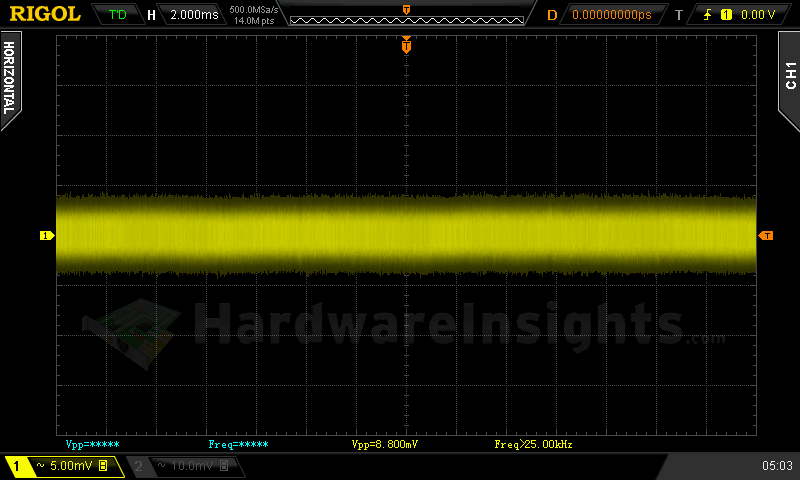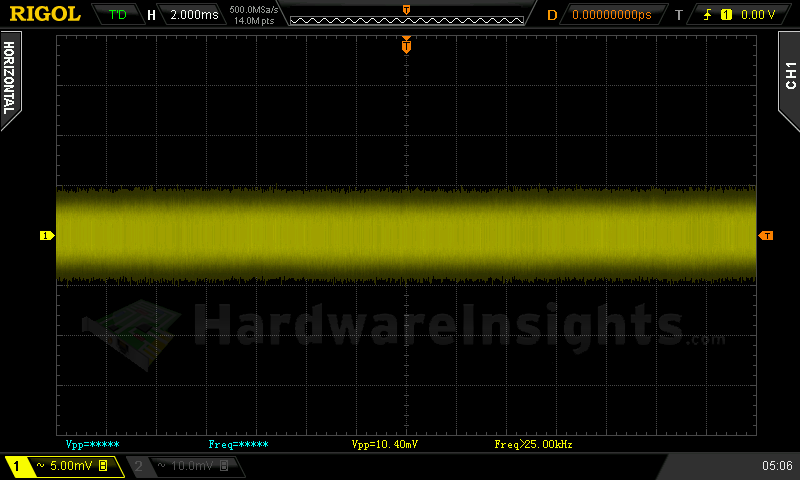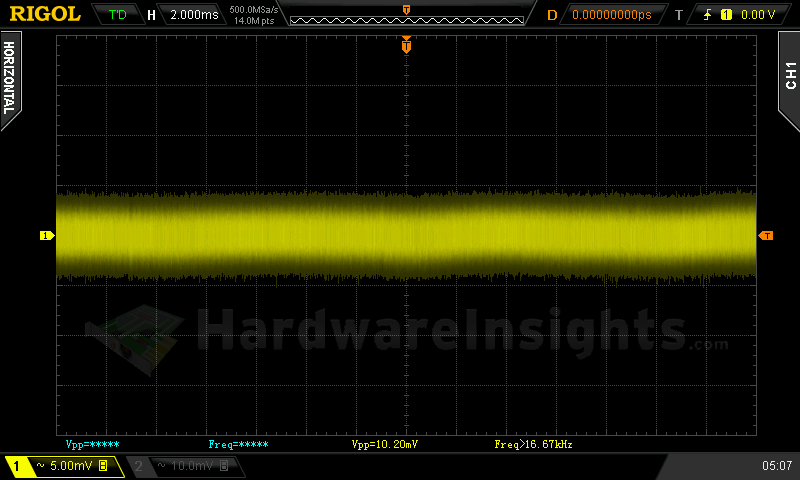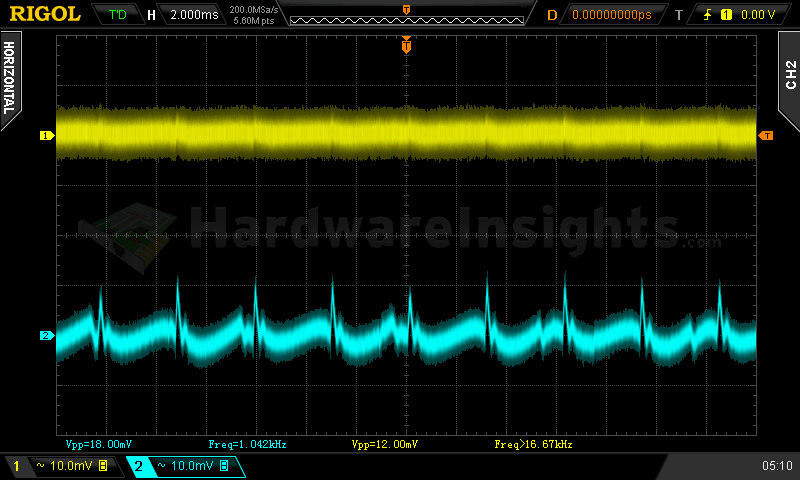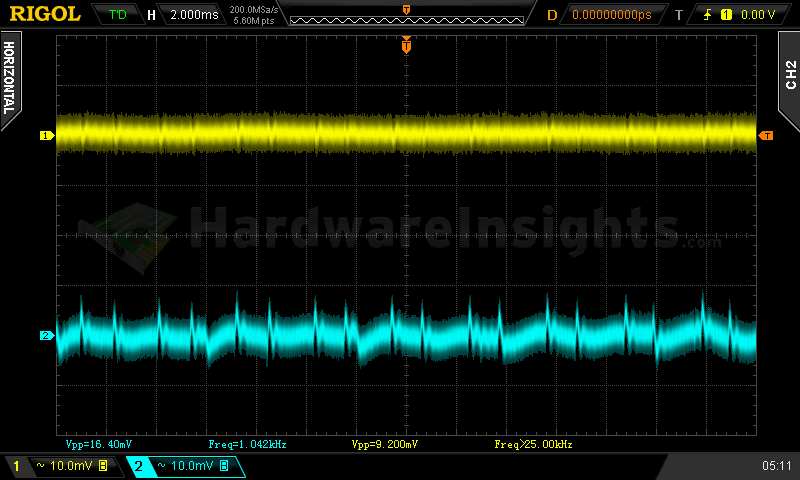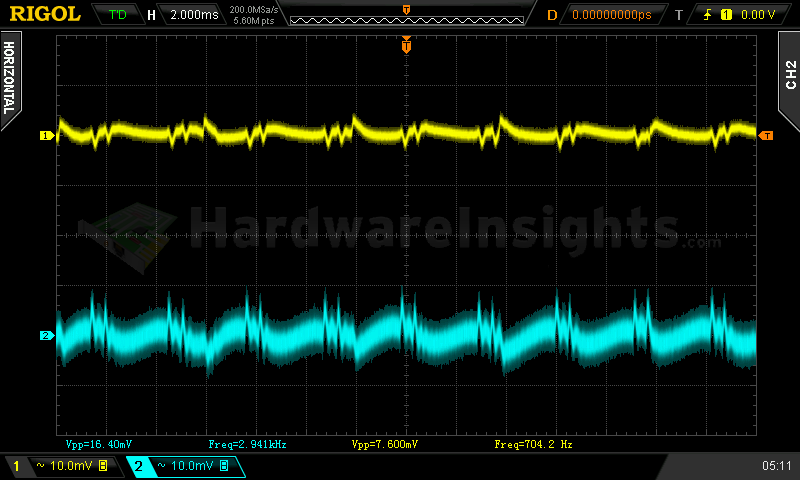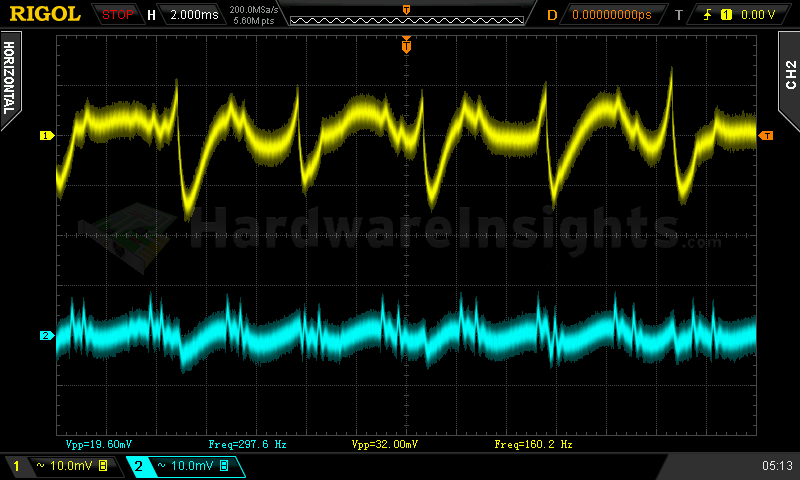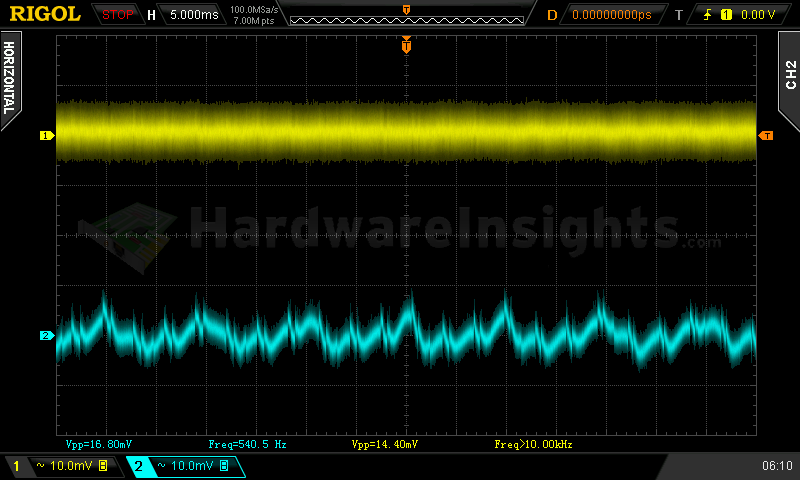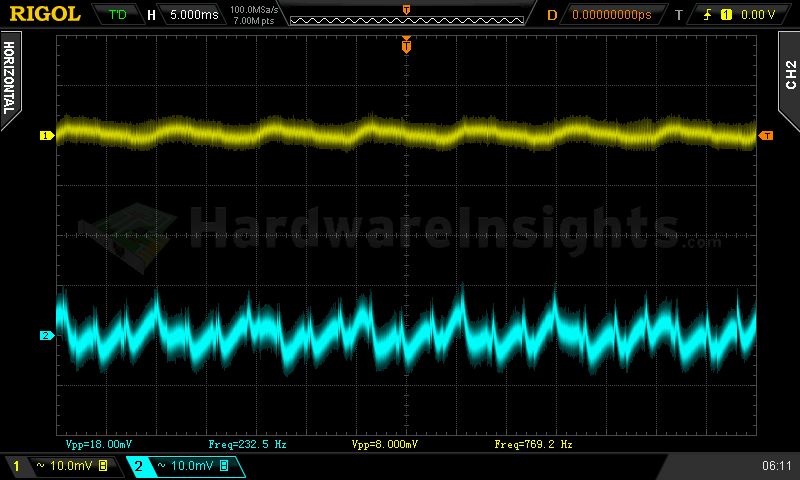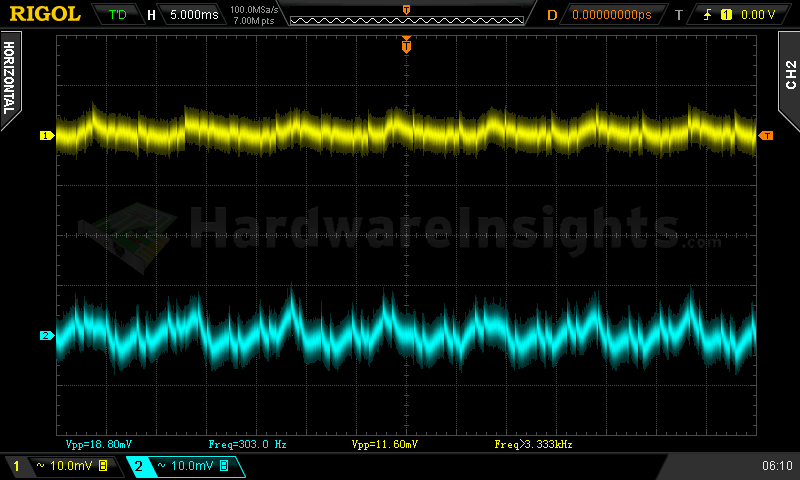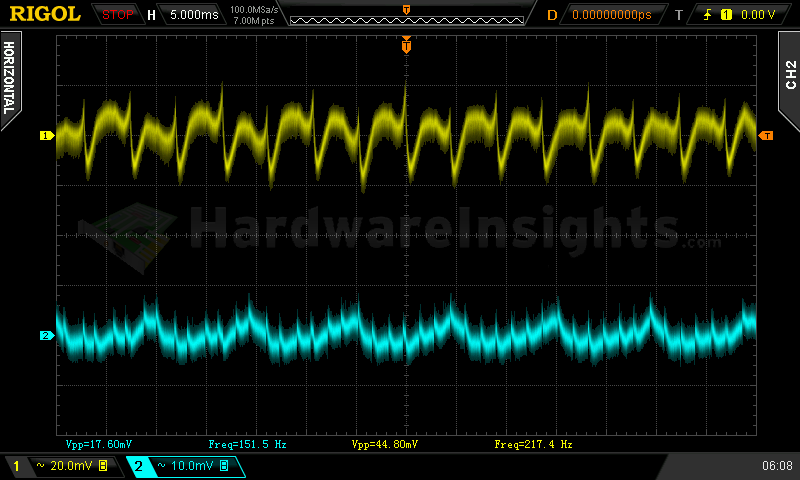Contents
- 1Introducing the Spire Jewel 350 W (SP-ATX-350WT-PFC)
- 1.1Packaging and accessories
- 2Connectors & cabling
- 2.1Casing & cooling
- 3Input filtering
- 4Primary side
- 4.1+5 V stand-by rail
- 5Secondary side
- 5.1Build quality
- 6Load testing
- 6.1Loading +5 V SB
- 6.2Hold-up time
- 6.3Combined loading
- 6.4Combined loading ripple
- 6.5Crossloading, overloading
- 6.6Crossloading, overloading ripple
- 6.7Fan speed, temperatures and noise
- 7Conclusion and evaluation
- 7.1Thanks
- 7.2Discussion
Load testing
Loading +5 V SB
As always, all load testing is done according to our testing methodology. The voltage regulation and ripple suppression is OK. Efficiency is poor, barely over 60 %. Under overload it dropped further and over 3 A output current the voltage dropped under ATX minimum. Plus as with the Whitenergy wonder, it has high no-load consumption of 2.25 W. So the Spire SP-ATX-350WT-PFC also does not comply with EUC order 1275/2008 and it is illegal to sell it in the whole EU!
| Output (W) | Load (A) | Voltage (V)/ ripple (mV) | Input (W) | Efficiency/power factor |
| 0 | 0 | 5.14/8.800 | 2.25 | —/0.434 |
| 19.36 | 1.91 | 5.00/10.40 | 15.72 | 60.6 %/0.660 |
| 23.26 | 3.04 | 4.44/10.20 | 23.75 | 56.7 %/0.685 |
+5 V SB ripple (left to right): 0 A; 1.91 A; 3.04A
Hold-up time
There is no hold-up time measurement as the unit failed to provide nominal power output.
Combined loading
Combined loading was OK for the Spire SP-350WT-ATX-PFC until test 5 (80% load). Though even under test 5 the unit was already smelling very badly. Most likely the main transformer was highly overheating and burning the lacquering. At test 6, the unit always turned off before it ever reach 300 W. So while it did not explode, it failed to provide nominal power thus failing in my testing. The power it provided was in spec though. Voltage regulation was as bad as could be expected from such topology.
| Output power | Load/ voltage +5 V SB | Load/ voltage +3.3 V | Load/ voltage +5 V | Load/ voltage +12 V | Load/ voltage −12 V | Input power | Efficiency/ power factor |
| 7.9 %/ 27.72 W | 0 A/ 5.14 V | 0 A/ 3.46 V | 0.345 A/ 5.15 V | 1.824 A/ 12.03 V | 0.363 A/ −11.04 V | 47.52 W | 58.3 %/ 0.721 |
| 20 %/ 70.54 W | 0.539 A/ 5.10 V | 1.500 A/ 3.43 V | 2.280 A/ 5.12 V | 3.88 A/ 12.05 V | 0.374 A/ −11.29 V | 99.05 W | 71.2 %/ 0.758 |
| 40 %/ 140.03 W | 1.028 A/ 5.06 V | 7.01 A/ 3.42 V | 7.63 A/ 5.00 V | 5.60 A/ 12.20 V | 0.375 A/ −11.70 V | 192.0 W | 72.9 %/ 0.752 |
| 60 %/ 208.98 W | 1.49 A/ 5.03 V | 9.76 A/ 3.41 V | 13.81 A/ 4.87 V | 7.78 A/ 12.36V | 0.394 A/ −12.21 V | 296.2 W | 70.6 %/ 0.716 |
|
80 %/ 277.58 |
1.82 A/ 5.00 V | 12.13 A/ 3.38 V | 16.82 A/ 4.79 V | 11.44 A/ 12.37 V | 0.424 A/ −12.80 V | 430.0 W | 64.6 %/ 0.697 |
| 83 %/ 292.18 W | 1.79 A/ 5.01 V | 12.11 A/ 3.38 V | 19.85 A/ 4.75 V | 11.48 A/ 12.44 V | 0.400 A/ −12.96 V | 451.2 W | 64.8 %/ 0.700 |
This is true group-regulated unit with +5/+12 V feedback combined. Depending on the +5 V/+12 V loading ratio the voltages flow across the whole spectrum. Notice that under maximum possible load the +5 V is almost out of spec. The efficiency was low at about 65–70 % though it was hitting close to 75 % peak. That is not so catastrophic, I expected lower overall efficiency. Though still poor for modern standards.
Combined loading ripple
The ripple values of the SP-ATX-350WT-PFC are surprisingly very nice. The high-frequency noise is low, but you can see the 100Hz ripple on the images caused by low input capacitance. I wonder what part in such low ripple plays the fact there is no active PFC. It is quite possible the ripple results of many units are bad because of the APFC, especially with small bulk capacitors. I think I will do some research in this area…
| Output % | Ripple +5 V SB | Ripple +3.3 V | Ripple +5 V | Ripple +12 V | Ripple −12 V |
| 7.9 | 12.00 mV | 9.200 mV | 7.600 mV | 19.60 mV | 32.00 mV |
| 20 | 11.60 mV | 5.200 mV | 10.80 mV | 18.40 mV | 31.20 mV |
| 40 | 11.60 mV | 7.600 mV | 12.00 mV | 15.60 mV | 32.80 mV |
| 60 | 12.00 mV | 7.600 mV | 9.200 mV | 16.40 mV | 41.60 mV |
| 80 | 12.80 mV | 8.000 mV | 15.60 mV | 19.60 mV | 42.40 mV |
| 83 | 14.40 mV | 8.00 mV | 11.60 mV | 18.80 mV | 44.80 mV |
Ripple 7.9% load (left to right): +5 V SB; +3.3 V; +5 V; −12 V. The second channel is connected to +12 V.
Ripple 83% load (left to right): +5 V SB; +3.3 V; +5 V; −12 V. The second channel is connected to +12 V.
Crossloading, overloading
Crossloading tests were the worst, as could be expected from such topology. Crossloading of the +3.3 V rail, and surprisingly also +12 V went fine. But with +5 V the worst of the unit came out. With slightly less than 25 A on that rail the voltage dropped to 4.60 V while on +12 V it rose as high as 12.94 V. This does not comply even with ATX 1.3 (for 300W unit at least). But I went ahead and increased the output of the +12 V rail to over 70 W. The voltages were still out of spec. Garbage.
| Output power | Load/ voltage +5 V SB | Load/ voltage +3.3 V | Load/ voltage +5 V | Load/ voltage +12 V | Load/ voltage −12 V | Input power | Efficiency/ power factor |
| 26 %/ 92.90 W | 0.531 A/ 5.10 V | 16.55 A/ 3.36 V | 1.544 A/ 5.07 V | 1.834 A/ 12.17 V | 0.391 A/ −11.35 V | 145.8 W | 63.7 %/ 0.770 |
| 43 %/ 150.04 W | 0.539 A/ 5.10 V | 1.462 A/ 3.43 | 24.5 A/ 4.60 V | 1.922 A/ 12.94 V | 0.384 A/ −12.26 V | 223.3 W | 67.2 %/ 0.743 |
| 48 %/ 167.59 W | 0.536 A/ 5.10 V | 1.464 A/ 3.43 V | 1.596 A/ 5.23 V | 12.65 A/ 11.62 V | 0.386 A/ −11.65 V | 228.5 W | 73.3 %/ 0.745 |
The efficiency while crossloading +3.3/+5 V rails was tragic, not even 70 %. Overloading was not possible as the unit turned off under 300 W each time. So while it has overload protection, it actually has even load protection as it does not even output labeled power. Short-circuit protection works.
Crossloading, overloading ripple
Here the ripple was also OK.
| Output % | Ripple +5 V SB | Ripple +3.3 V | Ripple +5 V | Ripple +12 V | Ripple −12 V |
| 26 | 12.40 mV | 21.60 mV | 15.60 mV | 20.80 mV | 35.20 mV |
| 43 | 12.40 mV | 8.400 mV | 15.60 mV | 21.60 mV | 37.60 mV |
| 48 | 14.40 mV | 8.800 mV | 15.60 mV | 21.60 mV | 38.00 mV |
Fan speed, temperatures and noise
The fan inside the Spire SP-ATX-350WT-PFC started spinning right when the unit powered on. And as expected, it ran on the full speed the whole time. I did not even measure how noisy it was as it is clear it is loud. As the unit is dangerous PoS I don’t think anybody would really like to use it so why waste time measuring the noise…
| Output % | Fan speed (RPM) | Temperature intake/ outtake | Noise (dBA) |
| 7.9 | 1770 | 28 °C/ 31 °C | — |
| 20 | 1770 | 29 °C/ 32 °C | — |
| 40 | 1782 | 30 °C/ 34 °C | — |
| 60 | 1794 | 30 °C/ 44 °C | — |
| 80 | 1798 | 32 °C/ 53 °C | — |
| 83 | 1800 | 32 °C/ 59 °C | — |
| CL 26 | 1770 | 31 °C/ 41 °C | — |
| CL 43 | 1842 | 31 °C/ 41 °C | — |
| CL 48 | 1732 | 31 °C/ 41 °C | — |
At the maximum power the unit delivered it was running very hot even despite the fan speed. Most of the heat came from the central area and also it smelled very bad. I presume the main transformer was overheating, burning the insulation lacquer. This unit is really not safe for anything modern, the best it can power is maybe Pentium III. Athlon XP without dedicated graphics at most. If it was not dangerous because of the Y capacitors…
